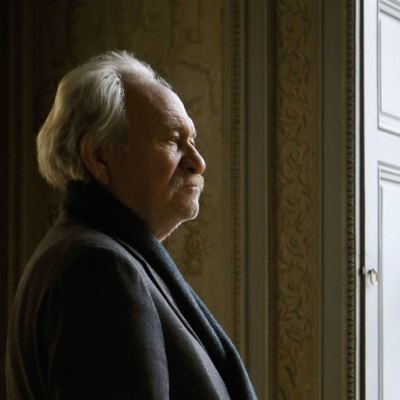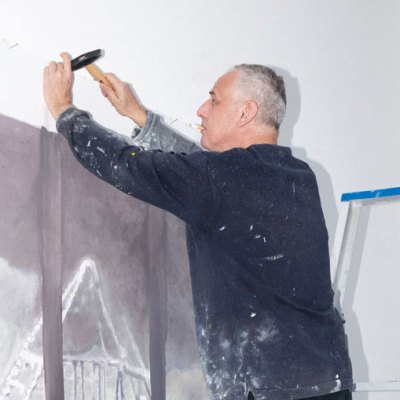Ettore Spalletti’s studio is in a small industrial complex, shared with a biscuit factory, on one of the serpentine hill roads of the legendarily dangerous car race that used to burn through the coastal city of Pescara and its surrounding villages. The artist remembers how crowds lined the streets to watch the drivers, and how haystacks were placed at sharp corners, such as the one leading up to his studio, so as to cushion crashes. The modern pebbledash building offers few clues as to the minimalist, private gallery inside: an enormous white cube in which Spalletti (b. 1940), who represented Italy at the 1997 Venice Biennale, likes to experiment with hangings. One wall is decorated with canvases destined for his upcoming show at the Marian Goodman Gallery in London, his first in the city, which takes its title – ‘Every dawn, is first’ – from a poem by Emily Dickinson.
The first time I encounter Spalletti he is emerging from one of his installations, a series of three artificially lit rooms he has built, with lowered vellum ceilings, like vestibules off his main studio space. They are lined with canvases – in the first room they are blue, the second pink, and the last white – all positioned at unruly angles from the wall so that their faceted planes catch the light to varying chromatic effect. These rooms, caught between painting and sculpture, seem agitated, pulling the eye in all directions, stubbornly refusing to settle down. Sometimes a white pencil, sharpened at both ends, serves as a structural prop, wedged between the frame and wall, to prevent the canvas bending; other monochromes are edged with gold leaf, which gives them an ethereal glow, as if they are further struggling to detach themselves from the wall.
‘Inside the rooms, the floor, the ceiling, the walls are white,’ Spalletti explains. ‘The paintings bestow colour to the whiteness, which then becomes pink in the red room, bluish in the blue room, and so on. The intensity of the light diffuses the pigments inside the space of the room, which becomes a transparent volume of colour. I wanted to have the feeling of being immersed in the colour…My colour gives you another colour, transforming continuously in a sort of colour that has no beginning and no end, stretching itself more and more until it hugs you, wrapping you completely.’
View of one of the three artificially lit immersive installations in Spalletti’s studio, which are lined with coloured canvases.
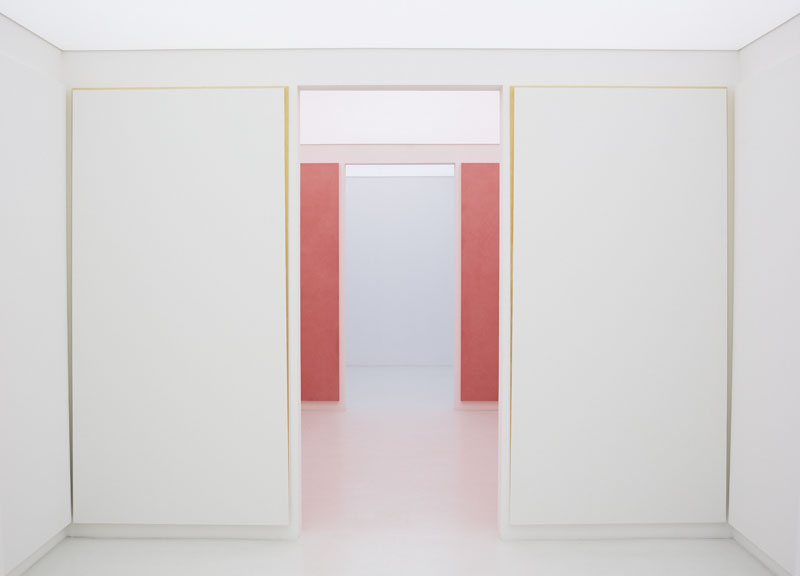
Spalletti, who, at 76, looks priestly in a black corduroy suit with a white shirt buttoned to the collar, is well-known for his luminous canvases and mannerist installations, which have been shown all around the world. They are always painted in different shades of blue, cobalt, ultramarine, pink, grey, or purplish red. His studio is punctuated by an army of irregular columns in these hues, placed in cohorts alongside bowls and blocks of alabaster, marble and onyx. The artist speaks softly in Italian and, gesturing for me to sit next to him at a round table in his office, sparks up a thin, gold-tipped Dunhill cigarette. He flicks the ash into a tiny silver receptacle as he smokes; every gesticulation he makes seems considered, almost as if he is moving in slow motion. On a shelf behind him is a photo of Yves Klein and Lucio Fontana, photographed in Paris at Galerie Iris Clert in 1961 (the year before Klein’s early death). ‘I never met Klein but I met Fontana several times,’ Spalletti says, looking up at his heroes. ‘He was a very elegant man.’
He shares Klein and Fontana’s love of colour blocks, lapis lazuli, gold and pink, their appreciation of medieval painting and Giotto’s skies, and the desire to go ‘beyond’ in painting, to the immaterial and transcendent. Spalletti’s palette was defined by Klein in the 1950s, when the French artist created an ex-voto dedicated to St Rita of Cascia, the patron saint of impossible and desperate causes, consisting of a Plexiglas box with three compartments filled with International Klein Blue, bright pink pigment and gold leaf. Spalletti, who was born in Cappelle sul Tavo, and has lived and worked within 5 km of the small hill town ever since, has spent his 40-year career experimenting, refining, and creating alchemy with combinations of these colours.
‘Blue is a colour that you almost can’t find in nature,’ Spalletti says of this obsessive research. ‘It is the colour of the atmosphere which we live in continuously. We are immersed in blue. Instead, pink is the colour of the skin, which is never fixed but is transformed according to the state of mind or mood you are experiencing. Renaissance painters, in order to make skin more livid, used to put green under pink.’ He thinks of his painting as an attempt to capture the effervescent play of colour and light. ‘Light shows me the colours, they are transformed continuously by the light, which moves and gives me the idea of another colour, so this is my work. I imagine the exhibition I am preparing for at Marian Goodman Gallery as if I were on a lawn, on the grass, throwing seeds and after many weeks I could watch flowers blooming in their different colours.’
View of Spalletti’s studio, which includes a selection of columns placed alongside other sculptural elements in pastel hues
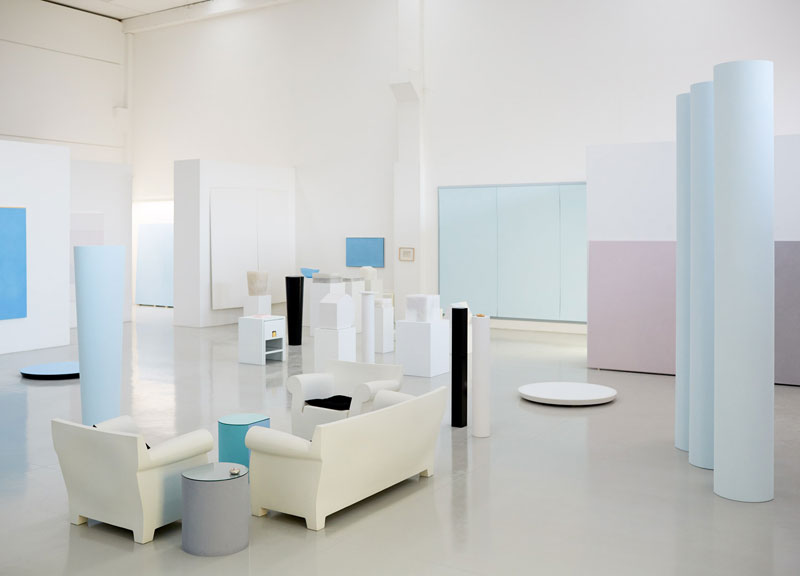
At the entrance to the studio is a large 1976 photo of Spalletti, crouched over a floor polishing two chalk tiles in the Galleria Pieroni in Pescara, a former Bourbon prison. In Spalletti’s 2014 retrospective, held simultaneously at the MAXXI Museum in Rome, MADRE in Naples, and GAM in Turin, this image served, in each space, to introduce his work. ‘It was at the level of the nearby river,’ Spalletti says of the Galleria Pieroni, ‘and when the river overflowed, it flooded and the prisoners used to climb on top of the sill of the windows to avoid the water. The pavement was made of big stones, and I thought to replace two of these stones with a shape cast of chalk, giving them two different colours, in order to allow a sense of serenity, of innocence, of the history of life which is often bad.’
The title of the work was E porgere, chissà da quale tempo, quanto rimane vivo (And proffering, who knows since when, whatever remains alive) and the photograph is black and white, but the colours were, invariably, pink and light blue. ‘I went there every day to clean the surface of the chalk casts with sandpaper, to keep them alive in the colour – that is what still happens in my work today. This slight sanding used to return a coloured powder all around the stones. It was the relationship with the architecture that interested me – there were four or five rooms. I left them all empty, except this presence on the floor.’
This early work was created under the influence of the Arte Povera movement and particularly Jannis Kounellis, with whom Spalletti was friends and neighbours in Cappelle sul Tavo. In the 1970s new art galleries opened in Pescara, such as the one owned by Mario Pieroni, who represented Kounellis, Mario Merz, Luciano Fabro, Francesco Lo Savio, and Vettor Pisani. Joseph Beuys also moved to Pescara for a time. ‘Those were the years of black and white and the colours were those only of the common materials employed,’ Spalletti says of Arte Povera. He began to feel a closer affinity to the Transavantgarde who, in reaction to the prevalent mood of conceptual abstraction, advocated the revival of painting and a return to art history. ‘I myself didn’t know what my colour was like, or where I belonged,’ Spalletti says. ‘The only thing I knew was that I loved colour.’
Spalletti, who looked for inspiration to Masaccio and Piero della Francesca, whose paintings often contrast pink flesh or robes with powder-blue skies, builds his colours with a ritual as laborious as that of a Renaissance master. ‘I prepare an impasto which contains pigments and chalk. I spread a thin layer of colour each day, almost at the same time [because of the consistency of light], for 15 days or more, depending on the thickness I want to get. In this time you can’t see the final colour, only at the end, when the pigments are dispersed on the surface through abrasion, you discover a totally different colour.’ When questioned about this technique of frottage, which renders the surface of the canvas powdery, velvety and opaque, Spalletti remarks that he is searching for ‘the pigment dust’s final burst’.
Spalletti won’t allow me into his adjacent workspace to better understand his process, considering it off-limits (his artistic performances of the 1970s are long behind him). He has spoken of his method as a precarious struggle to capture a fleeting colour, to trap it using geometry and then to break that geometry so that it dissolves, like smoke (one thinks of Leonardo’s sfumato technique). ‘I think that my work is revealed in a precise instant, because before the very last moment you would never know whether the work has succeeded or not. So I prefer to offer you that very last instant.’ He apparently can only begin painting after his studio floor has first been washed; a peek through the Venetian blinds from the car park reveals a bleached and spotless space, with canvas chairs positioned in a row opposite two grey canvases on a shelf. He continues to work on his paintings and sculptures in his larger, blindingly white gallery. ‘As long as they are in my studio, they are never finished,’ he says.
A stack of models in Spalletti’s studio showing his immersive rooms, each one dominated by a block of colour.
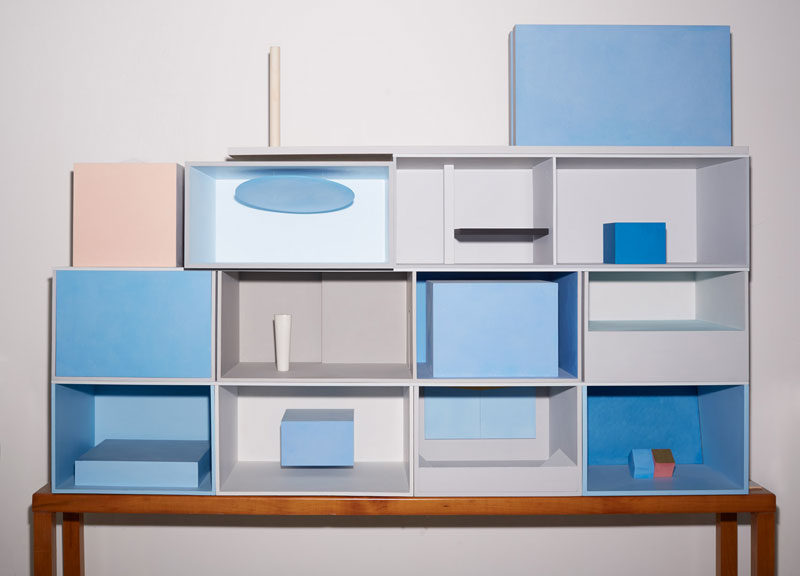
Spalletti’s father was a carpenter, who used to build his canvases, and his mother an embroiderer, who named all his colours after the spools of thread she used in her creations: pearl grey, ash blue, azalea pink, cyclamen, orchard lilac, coral pink. He went to art school in Pescara, where he attended lectures by the architect Aldo Rossi, and where he later taught (one of his recurring sculptural forms, an elongated monopoly house, resembles Rossi’s famous beach huts of Elba). The city, with its sandy shore, is now a busy construction site, and Spalletti laments its overdevelopment and ruin. ‘Despite that, the Adriatic Sea keeps the highest chromatic values,’ he says, explaining that he finds inspiration on beach walks. One of the paintings destined for London consists of five bands of graded colour: ‘I wanted the lines of the landscape to be built with colours that touch one another. It is like when you go for a walk on the beach and you watch the sea, then the blue gets deeper, then the skyline, then the sky itself – by twilight it becomes all silver. The sea and the sky meet, and you have the feeling that the space opens as if to meet infinity.’
‘Now you have to go closer to the mountains to discover the landscape that I remember from my childhood,’ he adds, explaining that he has always worked in the shadow of the snow-capped Gran Sasso, the highest mountain in the Apennines which overlaps with smaller mountains to form a silhouette known as ‘La Bella Addormentata’ or ‘sleeping beauty’. You can sometimes see its distinctive profile in his canvases, a line drawing that emerges through blocks of colour as though from mist, an effect that Spalletti describes as ‘like tossing an effervescent aspirin into water’. It is this sublimity that Spalletti has sought to harness in his work. ‘When you go out on a sunny day, it seems you have it at your hand,’ he says of the mountain peak.
Image2 The morgue in a building adjacent to the chapel at Città Sant’Angelo, designed by Spalletti and his wife Patrizia Leonelli, and showing a series of five identical rooms off an open corridor. Photo: Patrizia Leonelli
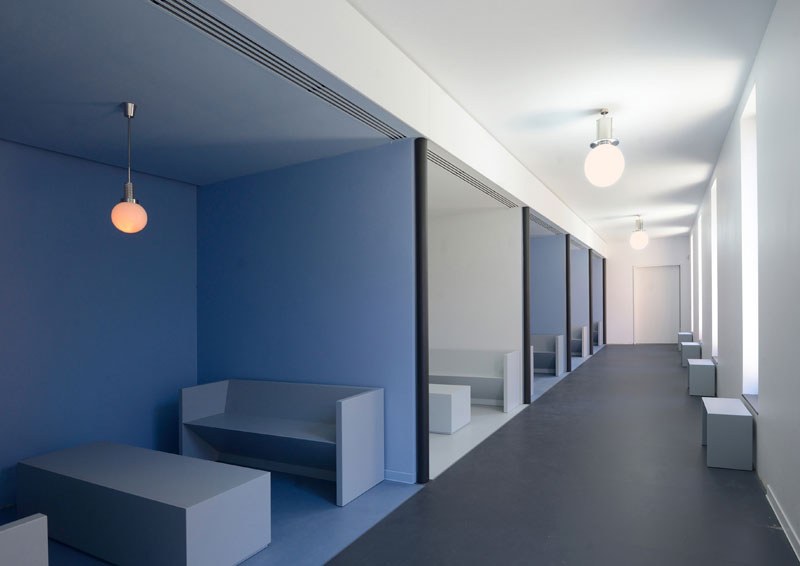
A wall of Spalletti’s studio is covered in models of his immersive rooms, which he calls ‘rooms for the spirit’, each one dominated by a sculptural block of colour. Some of them are huge pools of light-blue pigment that dominate the floor, or boxes of colour that fill the room or hover in space, while others feature enormous disks which jut into walls like UFOs about to crash and shatter into a cloud of coloured pigment. He made the first of these rooms in 1996 when he transformed his childhood bedroom into an ocean of blue, but when questioned about the Oedipal import of this intervention, Spalletti claims it was just sloth that made him choose this location. ‘The occasion was the exhibition titled “Territorio Italiano” (Italian Territory). Every artist could choose a space to place his work and my laziness conducted me to the right place. At that time I used to live with my mother and so I decided to make the work at my mother’s house, with the idea of having breakfast and then staying inside my work, having a daily visual relationship with the mood of the room.’
Spalletti and his wife, the architect Patrizia Leonelli, are currently transforming a 1960s brick building in the grounds of the Villa Serena clinic, in the neighbouring village of Città Sant’Angelo, into a chapel that will be decorated by the artist. It is one of his most ambitious projects to date, and will be inaugurated at the end of this year. Spalletti shows me renders of the space, which you will enter through high doors of sandblasted glass, their elongated frames making the shape of a cross. A centrepiece, consisting of eight blocks of marble with gold bands between them, repeats this motif. Flanked by two high, black marble columns, and acting as an altar, is an outsized ultramarine cube that fills the end of the nave and is raised from the ground so that it appears to hover in space. The interior walls are painted light blue, with monochrome canvases, edged in gold, marking the corners of walls; worshippers will sit on minimalist benches made of black ash. In an adjacent building is a morgue, with a series of five identical rooms off an open corridor, which will be used for displaying open coffins. Each room is painted a different shade of blue or grey to Spalletti’s design.
Image1 Rendering of the interior of the chapel at Città Sant’Angelo, designed by Spalletti and his wife Patrizia Leonelli, and showing the light blue interior walls and minimalist black benches. Photo: Patrizia Leonelli
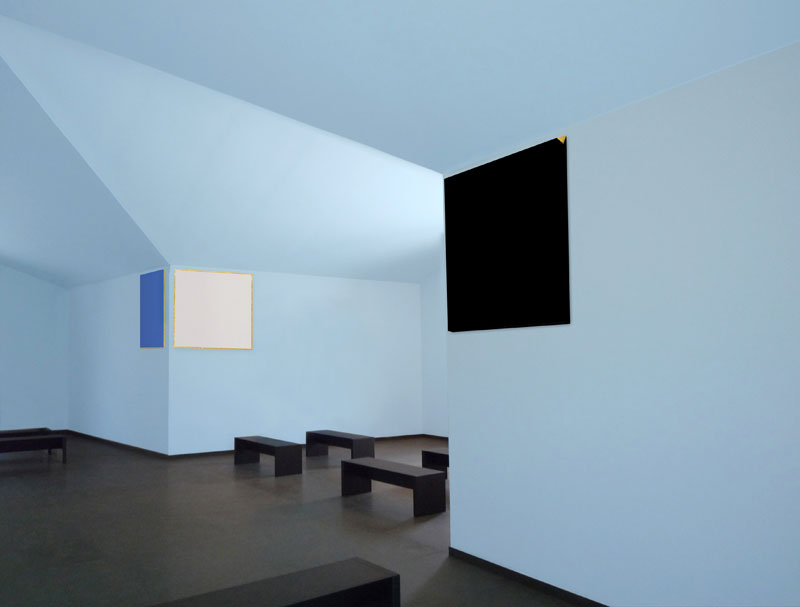
On the way back to the airport, after a feast of Abruzzian cuisine, we drive through Spalletti’s village, Spoltore. The five-storey house he shares with Leonelli dates from the fascist era and is tall and narrow, like a watchtower, with windows on all sides offering commanding views of the surrounding landscape. In Spalletti’s small garden, a square of concrete is painted his distinctive shade of blue, framed by a thin strip of grass like an empty swimming pool. As we continue, down the old Formula One racetrack, I begin to see similar Spalletti colours everywhere. A vacant, peeling billboard in Pescara seems to be a readymade monochrome, as do the Easter eggs and other confection displayed in a shopfront. And, when my aeroplane back to London pierces the clouds, the cambered wing catches the sunset and the grey aluminium suddenly glows a Spalletti rose, while below the powder-blue clouds stretch to infinity.
‘Every dawn, is first / Ogni alba, è la prima’ is at Marian Goodman Gallery, London, from 28 April–4 June.


